- Home
- Daniel Quinn
After Dachau
After Dachau Read online
BOOKS BY DANIEL QUINN
Ishmael
The Story of B
Providence:
The Story of a Fifty-Year Vision Quest
My Ishmael: A Sequel
Beyond Civilization:
Humanity’s Next Great Adventure
Tales of Adam
The Holy
Copyright © 2001 by Daniel Quinn
All rights reserved
First published by Context Books in 2001
For information about permission to reproduce
selections from this book, write to:
Steerforth Press L.C., 25 Lebanon Street,
Hanover, New Hampshire 03755
The Library of Congress has cataloged the
Context Books edition as follows:
Quinn, Daniel.
After Dachau : a novel / Daniel Quinn.
p. cm.
eISBN: 978-1-58195-240-7
1. Children of the rich—Fiction. 2. Reincarnation—Fiction. 3. Young men—Fiction. I. Title.
PS3567.U338 A69 2001
813′.54—dc21
00-012191
v3.1
For Beau Friedlander
Contents
Cover
Other Books by This Author
Title Page
Copyright
Dedication
Epigraph
Part one - Forgotten
Chapter 1
Chapter 2
Chapter 3
Chapter 4
Chapter 5
Chapter 6
Chapter 7
Chapter 8
Chapter 9
Chapter 10
Chapter 11
Chapter 12
Chapter 13
Chapter 14
Chapter 15
Part Two - Found
Chapter 16
Chapter 17
Chapter 18
Chapter 19
Chapter 20
Chapter 21
Chapter 22
Chapter 23
Chapter 24
Part Three - Risen
Chapter 25
Chapter 26
Chapter 27
Epilogue
Chapter 28
Chapter 29
A Note to Readers
Also by Daniel Quinn
Except for obviously historical persons such as Jackson Pollock, Willem DeKooning, Mark Rothko, Roy DeCarava, and Walter White, all persons mentioned or portrayed in this book are fictional.
The epigraphs introducing the various sections of this book are all from Vampires, Burial, and Death: Folklore and Reality, by Paul Barber.
FORGOTTEN
Bodies do not always stay buried.
ALL CHILDREN OF the rich and famous grow up believing they were switched at birth for the infants their parents really wanted, and I’m no exception. I’m Jason Tull—but not the rich and famous one, obviously. That’s my father.
Had my parents been given the infant they wanted, he would have grown up behaving exactly like a rightful heir, which is a thing I understand perfectly well but have never been able to do (and have rarely seen anyone else do). Perhaps it’s something genetic. Rightful heirs have special genes that kick in and take over at age five or six, and the rest of us don’t.
Naturally Mom and Dad assured me that nothing at all was expected of me just because I happened to be their son. They loved me for myself, and so on. But as one nears the end of school life (in my case, in the year 1992), the people close to you begin to hold their breath—to see if you’re possibly going to begin acting like a rightful heir after all. I didn’t, and before long everyone began to breathe normally again.
Instead of behaving like the rightful heir, I conceived an eccentric interest. This was the way my relatives perceived it, not the way I perceived it. Having nothing else in particular to live for, I found a hobby (they must have thought)—and a bizarre one to boot, just to prove I’m special. It irked me that they thought this way about it, but I know I might think the same in their place.
In my sophomore year at prep school I spent spring vacation with another son of rich and famous parents. My friend’s mother was a gaunt and melancholy person who whiled away her days reading. Mornings she spent in the morning room. After lunch she moved to one of several rooms that counted as living rooms. When the sun began its decline, she donned a sweater and moved to a shady spot by the pool. In the evening, before taking her book to bed, she seemed to feel obliged to spend an hour or two with the young master and his friend—a period that was painful to get through, as she was so clearly bored to stupefaction by the two of us.
All this leads up to the fact that I took a fancy to one of her books, which she’d left unguarded for a moment on the arm of a chair. I only had time to read the dust-jacket notes, which heightened my interest, and I began to wonder how I could get hold of it when she was done. She was the sort of person who would think it an impertinence to suggest that I might read the same books as she. A sort of sumptuary thing, like only kings wearing purple. She somehow gave the impression that the books she read had been written on commission for her exclusive use.
It was an impertinence even to ask what I actually asked, which was (in a very offhand way), “What do you do with all the books you read? Do you keep them somewhere here or donate them to a library or what?”
She was instantly on her guard—against what, I can’t guess.
She explained that her maid took them to a used-book dealer who evidently had the royal entitlement to resell all her paper castoffs. The rich mostly know very well how to pinch a penny.
The next day I angled in on the maid. You never know. Some servants are even haughtier than the people they serve, but I was lucky with this one, and a few hours later the book was delivered into my hands. It didn’t occur to me at the time that this book (or any book) was going to shape the direction of my life. At this age I didn’t even know that lives can have a direction.
IT WAS A STORY—purportedly a true story—about something that happened in a small midwestern town in the middle of the nineteenth century. I suppose it’s silly of me to be cagey about this. I later learned that this case was well known to people interested in such things, but at the time I not only didn’t know it was a well-known case, I didn’t even know it was a case—meaning an instance of a phenomenon. I thought I was reading about an event unparalleled in human history, completely unique.
In Vettsburg, Missouri, a little girl by the name of Mary Anne Dorson surprised her mother one day by starting to gossip about some people who lived on the other side of town, the Prescotts. The reason this surprised Mrs. Dorson was that the Dorsons didn’t know the Prescotts, though they were vaguely aware of their existence. She asked Mary Anne if she had met the Prescott children at school, and the little girl explained that the Prescott children were much grown up, no longer in school, though still living at home. So how did Mary Anne know them?
“I guess I know them from my dreams,” Mary Anne said.
This didn’t please her mother, who liked to think she was bringing up a child with her feet planted on the ground. She didn’t pursue the subject, but this didn’t end it either. Mary Anne not only went on talking, she began bringing forth details she couldn’t possibly know by any means whatever, which could only suggest she was making them up, fabricating them—lying, in short. Mrs. Dorson told her daughter very firmly that she didn’t intend to hear any more of this nonsense, not another word of it.
Stunned, Mary Anne fell silent. It was the beginning of summer in her eighth year. By the middle of the summer, the entire family was engulfed in her silence, which oppressed them like the still air before a thunderstorm. Mary Anne’s dresses hung on her like rags. She was los
ing weight, melting before their eyes. They took her to the family doctor, Dr. Jansen (telling him nothing of the Prescott business, of course), who found nothing in the world wrong with her. For her parents’ sake, he prescribed a tonic, told them to make sure she spent time playing outdoors every day, and so on.
Neither the tonic nor the sunshine helped. Finally, beaten, Mrs. Dorson begged Mary Anne to tell her what was wrong, praying she was not going to hear a single syllable of the name Prescott. The girl’s eyes filled with tears.
“I miss Mommy and Daddy,” she said. “I miss Connie and Francis” (those being the Prescott children).
Mrs. Dorson thought her heart would stop or her mind would explode from her head like a bird frightened from a tree. She was starkly terrified. She summoned her husband home from his office on the double, but even when he’d heard it all, he had no better idea what to do than she did.
Was their little girl insane? Devil-possessed? They almost would have preferred the latter. They took her back to Dr. Jansen, not to be examined this time but because they didn’t dare leave her at home or with a neighbor. When the doctor finally heard everything he should have heard in the first place, he didn’t waste time worrying about insanity or demonic possession. Though he didn’t know what was going on, he knew what had to be done, and that was to bring Mary Anne and the Prescotts together.
Faced with this idea, Mr. and Mrs. Dorson knew they’d rather have been forced to choose between the insane asylum and the exorcist. It needs to be mentioned, I’m afraid, that the Prescotts were several rungs below the Dorsons on the Vettsburg social ladder. To expose their family difficulties to people of that class was completely unthinkable (though I suspect it was rather more unthinkable for Mrs. Dorson than for her husband).
Seeing that the Dorsons would have to be brought to the idea by stages, Dr. Jansen made this suggestion. Through his contacts in the medical community, he’d check out the Prescotts and make sure they weren’t the sort of people who would take advantage of this strange situation. Then if they passed this inspection, he himself would undertake to contact them.
“But what do you hope to gain from this?” Mr. Dorson asked.
“In a matter like this,” the doctor said, “we’re like people trapped in a cave. We can sit here and starve to death or we can set off to explore the only corridor that presents itself and hope for the best.”
The Dorsons reluctantly agreed.
But there was something else Dr. Jansen wanted first, and that was to satisfy himself that he wasn’t being gulled. He had a scientific turn of mind, and his first hypothesis in this case wasn’t going to be that something uncanny was going on. Though he didn’t say so to the Dorsons, his first hypothesis was going to be that Mary Anne was playing a mean practical joke on her parents, possibly with the collusion of one or more of the Prescotts or of someone who knew them.
During the fortnight that followed, the doctor spent two or three hours a day with either the girl or her mother. Mrs. Dorson insisted it was completely impossible to suppose that some outsider was coaching her daughter. Mary Anne wasn’t one of a passel running wild; she was an only child living virtually every minute under her mother’s gaze. She had two or three friends she visited occasionally, but these weren’t people who would have any connection with the Prescotts, though of course the doctor was free to check this for himself—and he did.
You could see in the telling that Dr. Jansen was really getting into his role as investigator. His tests and stratagems were ingenious, subtle, and persuasive. But unless these very ordinary middle-class families were all joined in a fiendish conspiracy (and to what point?), Mrs. Dorson was right: Mary Anne had not been coached. Nor had she pieced together her picture of the Prescotts from things she’d heard or overheard at her friends’ homes. The Prescotts were unknown to them all.
The doctor’s next hypothesis was that the girl’s babblings about the Prescotts comprised the sort of generalities that fortune tellers make their reputations on. If pressed, she’d shy away from details. If pressed harder, she’d start inventing things and soon get tangled in discrepancies and contradictions. The hypothesis foundered immediately. Mary Anne was eager to supply details of the most minute kind and was unruffled by any challenge.
The doctor’s next and final hypothesis was that even if Mary Anne’s lies were internally consistent, they’d collapse when compared to actuality. Of necessity, this brought him face to face with the Prescotts themselves. He proceeded with the confidence of a Grand Inquisitor, presenting himself at their house unannounced, practically accusing them of perpetrating a confidence swindle on the Dorsons. They stared at him with such open-mouthed incomprehension that he couldn’t doubt what he’d already heard from others, that they were a family of thoroughly prosaic and innocuous working-class people. He apologized for having made this blustery beginning and went on to explain why he was there. When they finally understood what had been happening at the Dorson house, Dr. Jansen asked if they could imagine any ordinary way Mary Anne could have come into possession of detailed information about their lives and household arrangements. When they gave the expected answer, it was time to test the information itself.
He’d divided it into statements he could verify with his own eyes (descriptions of the house and family members) and statements only the Prescotts could verify (habits, history, And so on). It would serve no purpose to recite the process here. The material Mary Anne had provided was a mass of hits and misses, but not a hodgepodge. By the time they were finished, the character of the data was unmistakable. It was remarkably accurate—but ten years out of date.
Connie and Francis were no longer living with their parents, for example. Connie was married and had a home of her own. Francis had joined the army and was now a career soldier. Many of the furnishings and decorations Mary Anne had described were gone, but they’d certainly been there ten years ago.
The significance of “ten years ago” was no mystery to the Prescotts. Ten years ago they’d lost their firstborn, Natalie, to leukemia.
Now eight-year-old Mary Anne was telling anyone who would listen: “I am Natalie.”
The rest of the story is rather anticlimactic and more than a little chilling. When Mary Anne finally met the Prescotts, it was eerily like a reunion. Mrs. Prescott started weeping and couldn’t stop. Dr. Jensen finally had to administer a sedative and put her to bed. The Dorsons watched, frozen with horror and bewilderment, and when it was all over and they took their daughter home, they knew they’d lost her. It was an inevitable thing now. Two weeks later Mary Anne moved in with the people she considered her true parents, and that was the end of that.
News of the wonder couldn’t be suppressed. With the Prescott house at its center, Vettsburg became a place of pilgrimage for thousands who wanted to believe that Mary Anne was living proof of life after death and reincarnation. It would be nice to be able to say that the girl was unaffected by all this hullabaloo and grew into an angelic young woman, but it seems she grew into a perfectly normal young woman (one who, according to most witnesses, was a bit more than normally inclined to be sulky, spoiled, and demanding). She married twice, divorced twice, and in later life distinguished herself in no way whatever. Any sanctification that had come with being reborn in another girl’s body (if that’s what happened) was distinctly short-lived.
THIS WAS the version of the story that was put forward in the book I read at my friend’s home. Later I would read other versions that were neither so tidy nor so apparently conclusive. No matter—that was later.
The uncanny events of Vettsburg opened up a new dimension of sight for me. That’s the best way I can describe it. It’s as if I’d been living in a sort of flatland up till then, and this book directed my gaze up into a sky I’d never suspected was there. It was not in any sense a religious experience and confirmed no religious belief on my part, since I had none. In fact, I didn’t see religion as having anything to do with it and still don’t. If Natalie Prescott w
as in fact reincarnated as Mary Anne Dorson, then this was surely a wondrous event—but no more supernatural than a caterpillar being reincarnated as a butterfly. If Natalie Prescott was in fact reincarnated as Mary Anne Dorson, then this was surely just a manifestation of a natural law whose workings are usually not manifest at all. If Natalie Prescott was in fact reincarnated as Mary Anne Dorson, then we’re all the reincarnation of someone else—and destined to be reincarnated as someone else as well.
I slipped the book back to the maid, and that was that. The vacation came to an end, and I went back to school. Life continued as before—for another seven years, when I graduated from college and told my family I was going to work for We Live Again, a threadbare but earnest little organization devoted to reincarnation research.
They wanted to know what I meant by “work.” I explained that the foundation had only two paid full-time employees, the founder, Reginald Fenshaw, and his wife, Marcia, who coordinated and compiled the fieldwork of dozens of enthusiasts working on a volunteer basis around the world. I would in effect become their first full-time field-worker, bringing to the task not only my time and energy but the financial resources to follow up on reports anywhere in the world.
My mother thought the idea amusing and original, as if it were all an invention. My father thought it would make “an interesting way to spend the summer.” In his cunning and tactful way, he was opening an avenue down which I could retreat when the project began to bore me (as he was sure it would, sooner or later). However, he had a request. Before taking up my labors on behalf of We Live Again, he asked me to talk to “Uncle Harry,” who was coming to dinner the following evening. Of course I said I would.
Harold Whitaker, Ph.D., was a longtime close friend of the family (and not really any sort of uncle). I’d known him since childhood, when every adult seemed elderly, though in fact he wasn’t very old even now, being perhaps in his late thirties. I seemed always to have known the man’s legend better than the man himself. He’d studied at that frightfully ancient institution, Heidelberg University, and had a dueling scar on the left side of his face to prove it. He possessed several obscure academic degrees but said he favored the Ph.D. over the others because it didn’t need to be explained.

 The Story of B
The Story of B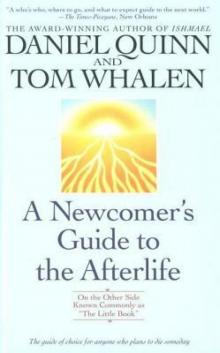 A Newcomer's Guide to the Afterlife: On the Other Side Known Commonly as the Little Book
A Newcomer's Guide to the Afterlife: On the Other Side Known Commonly as the Little Book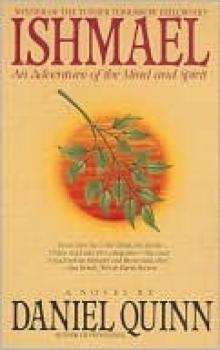 Ishmael: An Adventure of the Mind and Spirit
Ishmael: An Adventure of the Mind and Spirit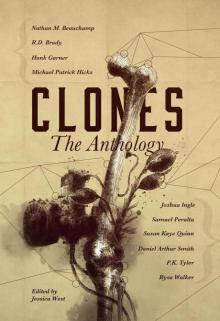 CLONES: The Anthology
CLONES: The Anthology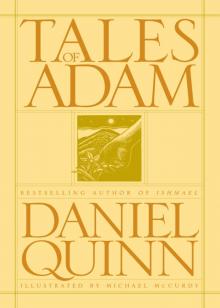 Tales of Adam
Tales of Adam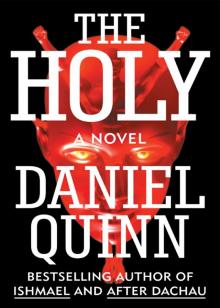 The Holy
The Holy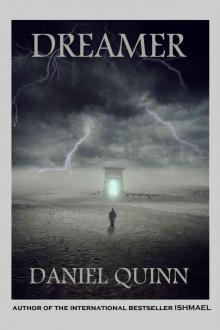 Dreamer
Dreamer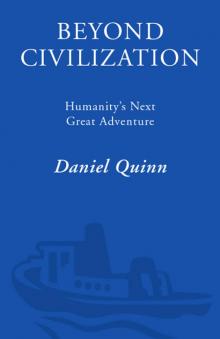 Beyond Civilization: Humanity's Next Great Adventure
Beyond Civilization: Humanity's Next Great Adventure After Dachau
After Dachau If They Give You Lined Paper, Write Sideways.
If They Give You Lined Paper, Write Sideways.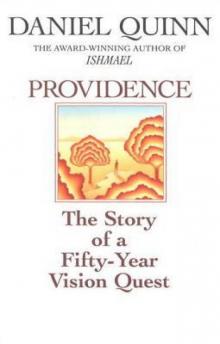 Providence
Providence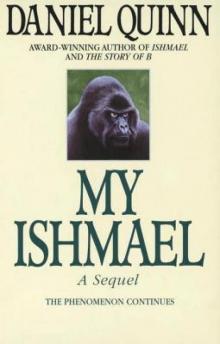 My Ishmael
My Ishmael Beyond Civilization
Beyond Civilization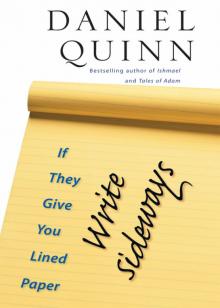 If They Give You Lined Paper, Write Sideways
If They Give You Lined Paper, Write Sideways Ishmael
Ishmael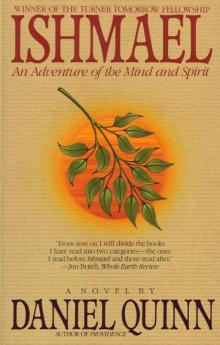 Ishmael i-1
Ishmael i-1 A Newcomer's Guide to the Afterlife
A Newcomer's Guide to the Afterlife